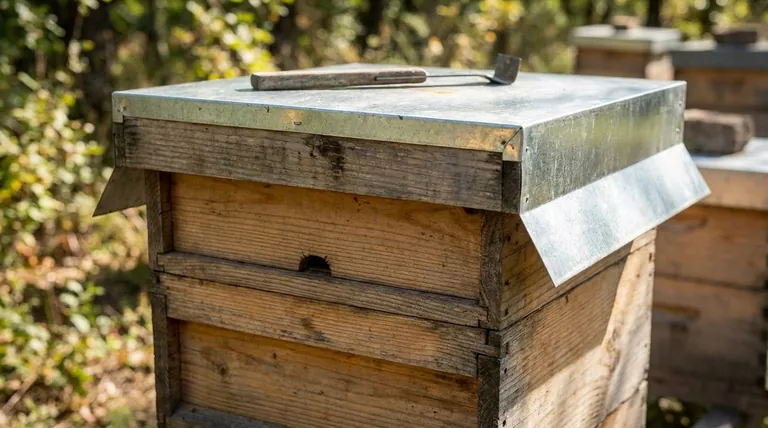At its core, a telescoping top is the most common type of beehive roof, designed as a protective outer cover. Made of wood and capped with a weather-resistant sheet of metal, its defining feature is its sides, which extend or "telescope" down over the top edges of the uppermost hive box.
The telescoping top is not just a simple lid; it is a two-part roofing system that works with an inner cover to provide superior weather protection, insulation, and hive stability. Understanding this synergy is key to managing a healthy colony.

The Core Function: More Than Just a Lid
A telescoping top's design addresses several critical needs of the hive simultaneously. It is an engineered solution for the colony's most exposed surface.
The "Telescoping" Fit
The name comes from the way the cover’s sides overhang the top hive body by a few inches.
This design creates a secure, friction-based fit that prevents wind from blowing the roof off, a common problem with simple, flat lids. It also provides a better seal against driving rain.
Weatherproofing and Durability
The top surface is almost always covered with a sheet of galvanized metal.
This metal cap is essential for longevity. It protects the wooden structure from sun, rain, and snow, preventing rot and leaks that could be catastrophic for the colony.
The Essential Inner Cover
The telescoping top does not sit directly on the hive box where the bees are. It rests on a separate, flat wooden board called the inner cover.
This inner cover creates a crucial layer of dead air space between the colony and the outer roof, which acts as insulation. It also features a small notch or hole, providing the bees with an upper entrance for ventilation and traffic.
Understanding the Practical Benefits
The combination of the telescoping top and the inner cover provides significant advantages for both the bees and the beekeeper.
Insulation and Condensation Control
The dead air space created by the inner cover is vital for thermoregulation. It helps keep the hive warmer in the winter and cooler in the summer.
During cold winter months, warm, moist air from the bees' cluster rises. The upper entrance provided by the inner cover allows this moisture to escape, preventing condensation from dripping back down onto the bees.
Simplified Hive Inspections
This two-part cover system makes hive inspections less disruptive.
A beekeeper can gently remove the outer telescoping top without immediately exposing the colony. This gives you a moment to place your tools and apply a puff of smoke through the inner cover's hole, calming the bees before you fully open the hive.
Common Pitfalls and Considerations
While the telescoping top is the industry standard, its effectiveness depends on proper use and awareness of a few key points.
The Propolis Seal
Bees will use propolis (a resinous "bee glue") to seal the gap between the inner cover and the telescoping top, as well as the gap between the inner cover and the hive body.
This seal can become incredibly strong, making it difficult to lift the cover. A hive tool is absolutely essential for prying these components apart without damaging them.
Ensuring Proper Ventilation
The system is designed for ventilation, but it isn't automatic. You must ensure the inner cover's entrance notch is not blocked by propolis or debris.
Many inner covers have a shallow side and a deep side. The deeper side is typically used in the summer for more airflow, while the shallower side is used in the winter.
Making the Right Choice for Your Hive
The telescoping top and inner cover combination is the most widely recommended setup for a reason. It is a proven, reliable system for nearly any beekeeping goal.
- If your primary focus is durability and weather protection: The telescoping top is the standard choice, offering superior protection from wind and rain compared to simpler migratory or flat covers.
- If your primary focus is winter survival in cold climates: This two-part system is critical, providing the insulation and moisture ventilation needed to help a colony survive the cold.
- If you are a new beekeeper: Starting with a standard telescoping top and inner cover is the best practice, as it provides the most versatile and forgiving setup for learning hive management.
Ultimately, mastering the use of the telescoping top is a foundational step in providing your colony with a safe, dry, and stable home.
Summary Table:
| Feature | Benefit |
|---|---|
| Telescoping Sides | Secure fit, prevents wind lift, seals against rain |
| Metal-Capped Roof | Durable, weatherproof, protects wood from rot |
| Inner Cover System | Provides insulation and upper entrance for ventilation |
| Propolis Seal | Bees naturally seal gaps for enhanced weatherproofing |
Ready to equip your apiary with durable, professional-grade telescoping tops?
At HONESTBEE, we supply commercial apiaries and beekeeping equipment distributors with high-quality, wholesale beekeeping supplies built to last. Our telescoping tops are crafted for superior weather protection and long-term hive stability.
Contact our wholesale team today to discuss your supply needs and discover how HONESTBEE can support your operation's success.
Visual Guide

Related Products
- Professional Insulated Winter Hive Wrap for Beekeeping
- Professional Galvanized Hive Strap with Secure Locking Buckle for Beekeeping
- HONESTBEE Professional Hive Top Bee Feeder Feeding Solution
- Endless Loop Ratchet Hive Strap
- Langstroth Bee Hives Bee Keeping Box for Beginners Beekeeping
People Also Ask
- Why is insulation important for hives during winter? Ensure Your Bees Survive and Thrive
- What factors ensure bees stay warm and healthy during winter? Master the 3 Keys to Hive Survival
- Is it always necessary to insulate beehives? A Guide to Winter Survival & Colony Health
- What are the benefits of insulated beehives in cold weather? Boost Winter Survival & Spring Productivity
- What is the advantage of an insulated outer cover? Boost Winter Survival & Spring Buildup



















